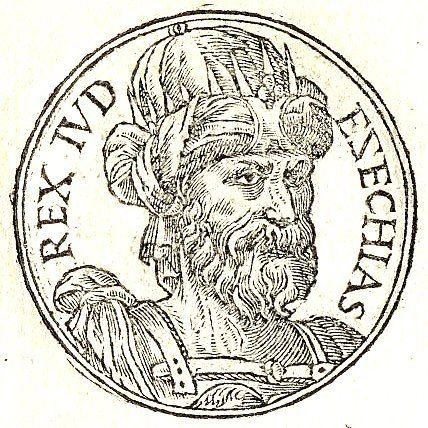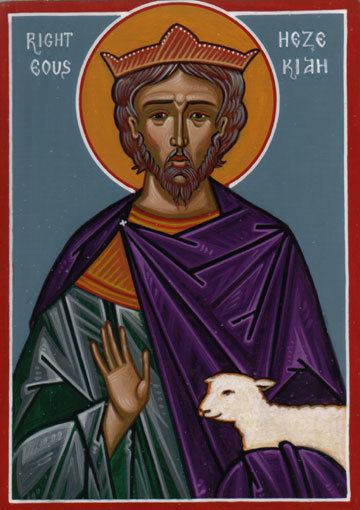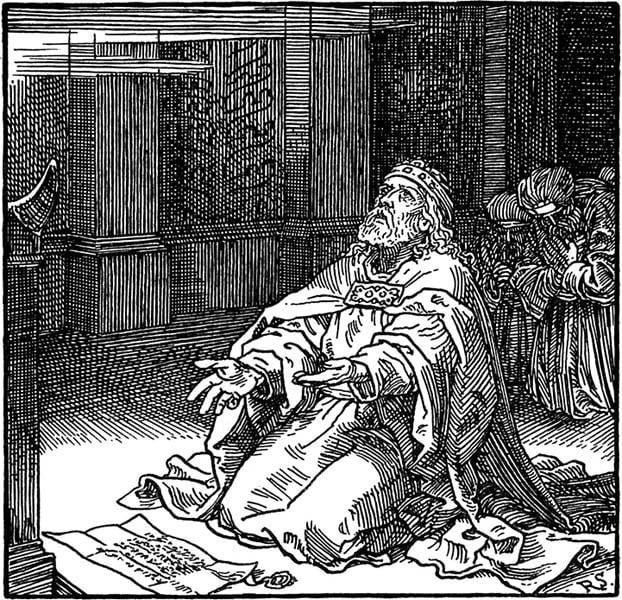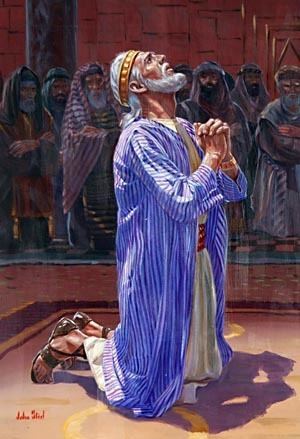Parents Abijah, Ahaz Royal line Davidic line Name Hezekiah Hezekiah | Burial Jerusalem Died 687 BC, Jerusalem, Israel Grandparents Jotham of Judah Spouse Hephzi-bah Children Manasseh of Judah | |
 | ||
Similar People Ahaz, Manasseh of Judah, Jotham of Judah, Josiah, David | ||
King hezekiah s seal impression found in the ophel excavations jerusalem
Hezekiah (, Hebrew: חִזְקִיָּ֫הוּ, חִזְקִיָּ֫ה, יְחִזְקִיָּ֫הוּ; Akkadian: Ḥazaqya'u; Greek: Ἐζεκίας [Septuagint, Εζεζία, Ezekias, Ezezía; Latin: Ezechias; also transliterated as Ḥizkiyyahu or Ḥizkiyyah) was, according to the Hebrew Bible, the son of Ahaz and the 13th king of Judah. Archaeologist Edwin Thiele has concluded that his reign was between c. 715 and 686 BC. He is considered a very righteous king by the author of the Book of Kings. He is also one of the most prominent kings of Judah mentioned in the Hebrew Bible and is one of the kings mentioned in the genealogy of Jesus in the Gospel of Matthew.
Contents
- King hezekiah s seal impression found in the ophel excavations jerusalem
- Hezekiah
- Etymology
- Extra Biblical records
- Archaeological record
- Increase in the power of Judah
- Siloam inscription
- Lachish relief
- Sennacheribs Prism of Nineveh
- Other records
- Chronological interpretation
- References

According to the Hebrew Bible, Hezekiah witnessed the destruction of the northern Kingdom of Israel by Sargon's Assyrians in c. 722 BC and was king of Judah during the invasion and siege of Jerusalem by Sennacherib in 701 BC. Hezekiah enacted sweeping religious reforms, including a strict mandate for the sole worship of God and a prohibition on venerating other deities within the Temple in Jerusalem. Isaiah and Micah prophesied during his reign.

Hezekiah
Etymology
The name Hezekiah means "Yahweh Strengthens" in Hebrew.
Extra-Biblical records
Extra-Biblical sources do much more for us than give us a pan-Mid Eastern picture into which we contextualize Hezekiah: there are extra-Biblical sources that specify Hezekiah by name, along with his reign and influence. "Historiographically, his reign is noteworthy for the convergence of a variety of biblical sources and diverse extrabiblical evidence often bearing on the same events. Significant data concerning Hezekiah appear in the Deuteronomistic History, the Chronicler, Isaiah, Assyrian annals and reliefs, Israelite epigraphy, and, increasingly, stratigraphy". Archaeologist Amihai Mazar calls the tensions between Assyria and Judah "one of the best-documented events of the Iron Age" (172). Hezekiah's story is one of the best to cross-reference with the rest of the Mid Eastern world's historical documents.
Archaeological record

A seal impression dating back to 727–698 BCE, reading "לחזקיהו [בן] אחז מלך יהדה" "Belonging to Hezekiah [son of] Ahaz king of Judah" was uncovered in a dig at the Ophel in Jerusalem. the impression on this inscription was set in ancient Hebrew script.

A lintel inscription, found over the doorway of a tomb, has been ascribed to his secretary, Shebnah (2 Kings 18:18). LMLK store jars along the border with Assyria "demonstrate careful preparations to counter Sennacherib's likely route of invasion" and show "a notable degree of royal control of towns and cities which would facilitate Hezekiah's destruction of rural sacrificial sites and his centralization of worship in Jerusalem". Evidence suggests they were used throughout his 29-year reign (Grena, 2004, p. 338). There are some Bullae from sealed documents that may have belonged to Hezekiah himself (Grena, 2004, p. 26, Figs. 9 and 10). There are also some that name his servants (ah-vah-deem in Hebrew, ayin-bet-dalet-yod-mem). However, they are all from the antiquities market and subject to authentication disputes (see Biblical archaeology).
Increase in the power of Judah

According to the work of archaeologists and philologists, the reign of Hezekiah saw a notable increase in the power of the Judean state. At this time Judah was the strongest nation on the Assyrian-Egyptian frontier. There were increases in literacy and in the production of literary works. The massive construction of the Broad Wall was made during his reign, the city was enlarged to accommodate a large influx, and population increased in Jerusalem up to 25,000, "five times the population under Solomon." Archaeologist Amihai Mazar explains, "Jerusalem was a virtual city-state where the majority of the state's population was concentrated," in comparison to the rest of Judah's cities (167). Archaeologist Israel Finkelstein says, "The key phenomenon—which cannot be explained solely against the background of economic prosperity—was the sudden growth of the population of Jerusalem in particular, and of Judah in general" (153). He says the cause of this growth must be a large influx of Israelites fleeing from the Assyrian destruction of the northern state. It is "[t]he only reasonable way to explain this unprecedented demographic development" (154). This, according to Finkelstein, set the stage for motivations to compile and reconcile Hebrew history into a text at that time (157). Mazar questions this explanation, since, he argues, it is "no more than an educated guess" (167).
Siloam inscription
The Siloam Tunnel was chiseled through 533 meters (1,750 feet) of solid rock in order to provide Jerusalem underground access to the waters of the Gihon Spring or Siloam Pool, which lay outside the city.
The Siloam Inscription from the Siloam Tunnel is now in the Istanbul Archeological Museum. It "commemorates the dramatic moment when the two original teams of tunnelers, digging with picks from opposite ends of the tunnel, met each other" (564). It is "[o]ne of the most important ancient Hebrew inscriptions ever discovered." Finkelstein and Mazar cite this tunnel as an example of Jerusalem's impressive state-level power at the time.
Archeologists like William G. Dever have pointed at archaeological evidence for the iconoclasm during the period of Hezekiah's reign. The central cult room of the temple at Arad (a royal Judean fortress) was deliberately and carefully dismantled, "with the altars and massebot" concealed "beneath a Str. 8 plaster floor". This stratum correlates with the late 8th century; Dever concludes that "the deliberate dismantling of the temple and its replacement by another structure in the days of Hezekiah is an archeological fact. I see no reason for skepticism here."
Lachish relief
Under Rehoboam, Lachish became the second most important city of the kingdom of Judah. During the revolt of king Hezekiah against Assyria, it was captured by Sennacherib despite determined resistance (see Siege of Lachish).
As the Lachish relief attests, Sennacherib began his siege of the city of Lachish in 701 BC. The Lachish Relief graphically depicts the battle, and the defeat of the city, including Assyrian archers marching up a ramp and Judahites pierced through on mounted stakes. "The reliefs on these slabs" discovered in the Assyrian palace at Nineveh "originally formed a single, continuous work, measuring 8 feet ... tall by 80 feet ... long, which wrapped around the room" (559). Visitors "would have been impressed not only by the magnitude of the artwork itself but also by the magnificent strength of the Assyrian war machine."
Sennacherib's Prism of Nineveh
Sennacherib's Prism was found buried in the foundations of the Nineveh palace. It was written in cuneiform, the Mesopotamian form of writing of the day. The prism records the conquest of 46 strong towns and "uncountable smaller places," along with the siege of Jerusalem where Sennacherib says he just "shut him up...like a bird in a cage," subsequently enforcing a larger tribute upon him.
The Hebrew Bible states that during the night, the angel of Jehovah (YHWH Hebrew) brought death to 185,000 Assyrians troops (2 Kings 19:35), forcing the army to abandon the siege, yet it also records a tribute paid to Sennacherib of 300 silver talents following the siege. There is no account of the supernatural event in the prism. Sennacherib's account records his levying of a tribute from Hezekiah, the king of Judea, who was within Jerusalem, leaving the city as the only one intact following the exile of the northern ten-tribe kingdom of Israel due to idolatry. (2 Kings 17:22,23; 2 Kings 18:1-8) Sennacherib recorded a payment of 800 silver talents, which suggests a capitulation to end the siege. However, Inscriptions have been discovered describing Sennacherib’s defeat of the Ethiopian forces. These say: “As to Hezekiah, the Jew, he did not submit to my yoke, I laid siege to 46 of his strong cities . . . and conquered (them) . . . Himself I made a prisoner in Jerusalem, his royal residence, like a bird in a cage.” (Ancient Near Eastern Texts, p. 288) He does not claim to have captured the city. This is consistent with the Bible account of Hezekiah’s revolt against Assyria in the sense that neither account seems to indicate that Sennacherib ever entered or formally captured the city. Sennacherib in this inscription claims that Hezekiah paid for tribute 800 talents of silver, in contrast with the Bible’s 300, however this could be due to boastful exaggeration which was not uncommon amongst kings of the period. Furthermore, the annals record a list of booty sent from Jerusalem to Nineveh. In the inscription, Sennacherib claims that Hezekiah accepted servitude, and some theorize that Hezekiah remained on his throne as a vassal ruler. (The campaign is recorded with differences in the Assyrian records and in the biblical Books of Kings; there is agreement that the Assyrian have a propensity for exaggeration).
One theory that takes the biblical view posits that a defeat was caused by "possibly an outbreak of the bubonic plague" (303). Another that this is a composite text which makes use of a 'legendary motif' analogous to that of the exodus story.
Other records
The Talmud (Bava Batra 15a) credits Hezekiah with overseeing the compilation of the biblical books of Isaiah, Proverbs, Song of Songs and Ecclesiastes.
According to Jewish tradition, the victory over the Assyrians and Hezekiah's return to health happened at the same time, the first night of Passover.
The Greek historian, Herodotus (c. 484 BC – c. 425 BC), wrote of the invasion and acknowledges many Assyrian deaths, which he claims were the result of a plague of mice. The Jewish historian, Josephus, followed the writings of Herodotus. These historians record Sennacherib's failure to take Jerusalem is "uncontested".
Chronological interpretation
Understanding the biblically recorded sequence of events in Hezekiah's life as chronological or not is critical to the contextual interpretation of his reign. According to scholar Stephen L. Harris, chapter 20 of 2 Kings does not follow the events of chapters 18 and 19 (161). Rather, the Babylonian envoys precede the Assyrian invasion and siege. Chapter 20 would have been added during the exile, and Harris says it "evidently took place before Sennacherib's invasion' when Hezekiah was "trying to recruit Babylon as an ally against Assyria.' Consequently, "Hezekiah ends his long reign impoverished and ruling over only a tiny scrap of his former domain.' Likewise, The Archaeological Study Bible says, "The presence of these riches' that Hezekiah shows to the Babylonians "indicates that this event took place before Hezekiah's payment of tribute to Sennacherib in 701 BC" (564). Again, "Though the king's illness and the subsequent Babylonian mission are described at the end of the accounts of his reign, they must have occurred before the war with Assyria. Thus, Isaiah's chastening of Hezekiah is due to his alliances made with other countries during the Assyrian conflict for insurance. To a reader who interprets the chapters chronologically, it would appear that Hezekiah ended his reign at a climax, but with a scholarly analysis, his end would contrarily be interpreted as a long fall from where he began.
